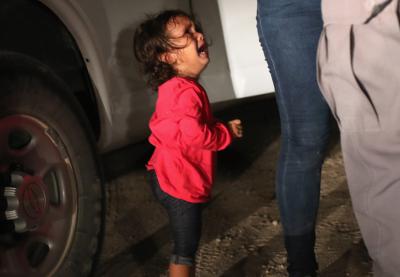Editor's note: On June 20, 2018, President Trump issued an executive order ending the policy of family separation at the U.S. border. It is still unclear, however, when or how the more than 2,000 children already affected will be reunited with their parents.
I hear the shift of the shackles and see glimpses of orange jumpsuits through a crack in the door as one person after the next moves up to hear the charges against them. In the next three hours, 151 cases will be heard, about one every minute.
Among the masses of people rushed through the federal courthouse are asylum seekers who were taken into custody at authorized crossing points, mothers and fathers separated from their children upon entry into the United States. Assigned a unique “alien number,” the children are difficult—if not impossible—for their parents to find.
As I leave the federal courthouse, I watch as the security guards discuss preparations for the “prisoners” to be transported to detention centers, preparing for the next round to arrive for their hearing. Once processed through the system, parents will scramble to locate their children before their deportation date. When they’re not successful, they’re forced out of the country, leaving their children behind.
Just miles away from the courthouse, and from my classroom, sits the largest government-contracted migrant youth shelter in the country. Among the many heartbreaks of our current system is the fact that the children in this shelter—the ones who were torn from their parents to be housed in a repurposed Walmart—are actually luckier than the children who will be taken from their parents today. Those children will most likely be sent to one of the tent cities, hastily assembled as a response to this manufactured crisis and currently serving as what any Texan will tell you is a wholly inadequate answer to the heat of June and July.
As educators, we know the severity and the impact of trauma on our children. Those of us who are citizens must recognize the trauma that is being inflicted—today, right now—in the name of law and order. We must consider at the outset the dangers that are driving many of these migrant children here from their homes including human trafficking, violence and displacement from natural disasters. After surviving impossible conditions at home and a perilous journey to the U.S. border, these children have been torn from their parents’ arms. They are thrown into a system that clearly has no investments in their best interests and offers no assurance of when, or even if, they’ll be reunited with their parents again. This practice is an affront to the fundamental rights and dignity of children. It has been criticized by groups from all corners of our country and the world including the American Academy of Pediatrics, the Southern Baptist Convention and the U.S. Conference of Catholic Bishops. It’s a slap in the face and a blow to the heart of every educator who has worked to honor, love and nurture children.
Standing outside the courthouse doors, a contracted security guard turns to me. “You’ve never heard the screams of a five-year-old child like when you take her away from her parent,” he says. “It’ll put a chill down your spine.”
As educators, we know what to do when a child is in pain. When they’re lost or afraid, we don’t wait to learn more about the situation. We don’t blame their parents for their choices. Ensuring that children feel safe and loved is our primary job as educators, and we cannot rest until we see that all children, whether in our own classrooms or not, are being spared from the pain of this inhumane policy.
Monday, The Atlantic published a recording of children separated from their parents at the border. “They scream ‘Mami’ and “Papá” over and over again,” Ginger Thompson explains, “as if those are the only words they know.”
Now we’ve heard their screams. We have to ask ourselves: How will we use our voices to respond?
Griffith is a middle school social studies teacher in Brownsville, Texas.
As the crisis at the border continues to unfold, there are ways you can help.
If you’d like to donate money, The Texas Tribune has assembled a list of organizations working on behalf of children separated from their parents.
The Atlanta Journal Constitution has created a list of ways you can show your support beyond donations, including protesting and contacting elected officials, and Quartz makes additional suggestions.
If you’re looking for an event or protest to attend, Families Belong Together will allow you to search by zip code or state.
If you want to help children in your own community, Congressman Tony Cárdenas recommends donating supplies at a local refugee resettlement office.


1 COMMENTS